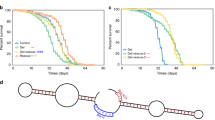Abstract
Mitochondria play essential roles in development and disease. The characterisation of mitochondrial proteins is therefore of particular importance. The slowmo (slmo) gene of Drosophila melanogaster has been shown to encode a novel type of mitochondrial protein, and is essential in the developing central nervous system. The Slmo protein contains a conserved PRELI/MSF1p′ domain, found in proteins from a wide variety of eukaryotic organisms. However, the function of the proteins of this family is currently unknown. In this study, the evolutionary relationships between members of the PRELI/MSF1p′ family are described, and we present the first analysis of two novel Drosophila genes predicted to encode proteins of this type. The first of these, preli-like (prel), is expressed ubiquitously during embryonic development, whilst the second, real-time (retm), is expressed dynamically in the developing gut and central nervous system. retm encodes a member of a novel conserved subclass of larger PRELI/MSF1p′ domain proteins, which also contain the CRAL-TRIO motif thought to mediate the transport of small hydrophobic ligands. Here we provide evidence that, like Slmo, both the Prel and Retm proteins are localised to the mitochondria, indicating that the function of the PRELI/MSF1p′ domain is specific to this organelle.





Similar content being viewed by others
References
Anantharaman V, Aravind L (2002) The GOLD domain, a novel protein module involved in Golgi function and secretion. Genome Biol 3:research0023.1–0023.7
Bonneton F, Wegnez M (1995) Developmental variability of metallothionein Mtn gene expression in the species of the Drosophila melanogaster subgroup. Dev Genet 16:253–263
Carhan A, Reeve S, Dee CT, Baines RA, Moffat KG (2004) Mutation in slowmo causes defects in Drosophila larval locomotor behaviour. Invertebr Neurosci 5:65–75
Casari G, De Fusco M, Ciarmatori S, Zeviani M, Mora M, Fernandez P, De Michele G, Filla A, Cocozza S, Marconi R, Durr A, Fontaine B, Ballabio A (1998) Spastic paraplegia and OXPHOS impairment caused by mutations in paraplegin, a nuclear-encoded mitochondrial metalloprotease. Cell 93:973–983
Fox EJ, Stubbs SA, Kyaw Tun J, Leek JP, Markham AF, Wright SC (2004) PRELI (protein of evolutionary and lymphoid interest) is located within an evolutionarily conserved gene cluster on chromosome 5q34–q35 and encodes a novel mitochondrial protein. Biochem J 378:817–825
Goldenthal MJ, Marín-García J (2004) Mitochondrial signaling pathways: a receiver/integrator organelle. Mol Cell Biochem 262:1–16
Guzman-Rojas L, Sims JC, Rangel R, Guret C, Sun Y, Alcocer JM, Martinez-Valdez H (2000) PRELI, the human homologue of the avian px19, is expressed by germinal center B lymphocytes. Int Immunol 12:607–612
Lai CH, Chou CY, Ch’ang LY, Liu CS, Lin W (2000) Identification of novel human genes evolutionary conserved in Caenorhabditis elegans by comparative proteomics. Genome Res 10:703–713
Li X, Xie Z, Bankaitis VA (2000) Phosphatidylinositol/phosphatidylcholine transfer proteins in yeast. Biochim Biophys Acta 1486:55–71
Nakai M, Takada T, Endo T (1993) Cloning of the YAP19 gene encoding a putative yeast homolog of AP19, the mammalian small chain of the clathrin-assembly proteins. Biochim Biophys Acta 1174:282–284
Niu S, Antin PB, Morkin E (1996) Cloning and sequencing of a developmentally regulated avian mRNA containing the LEA motif found in plant seed proteins. Gene 175:187–191
Schmidt HA, Strimmer K, Vingron M, von Haeseler A (2002) TREE-PUZZLE: maximum likelihood phylogenetic analysis using quartets and parallel computing. Bioinformatics 18:502–504
Thompson JD, Gibson TJ, Plewniak F, Jeanmougin F, Higgins DG (1997) The CLUSTAL_X windows interface: flexible strategies for multiple sequence alignment aided by quality analysis tools. Nucleic Acids Res 25:4876–4882
Toivonen JM, O’Dell KMC, Petit N, Irvine SC, Knight GK, Lehtonen M, Longmuir M, Luoto K, Touraille S, Wang Z, Alziari S, Shah ZH, Jacobs HT (2001) technical knockout, a Drosophila model of mitochondrial disease. Genetics 159:241–254
Torroja L, Ortuno-Sahagun D, Ferrus A, Hammerie B, Barbas JA (1998) scully, an essential gene of Drosophila, is homologous to mammalian mitochondrial type II L-3-hydroxyacyl-CoA-dehydrogenase/amyloid-β peptide binding protein. J Cell Biol 141:1009–1017
Truscott KN, Brandner K, Pfanner N (2003) Mechanisms of protein import into mitochondria. Curr Biol 13:R326–R337
Author information
Authors and Affiliations
Corresponding author
Additional information
Edited by P. Simpson
Rights and permissions
About this article
Cite this article
Dee, C.T., Moffat, K.G. A novel family of mitochondrial proteins is represented by the Drosophila genes slmo, preli-like and real-time. Dev Genes Evol 215, 248–254 (2005). https://doi.org/10.1007/s00427-005-0470-4
Received:
Accepted:
Published:
Issue Date:
DOI: https://doi.org/10.1007/s00427-005-0470-4




